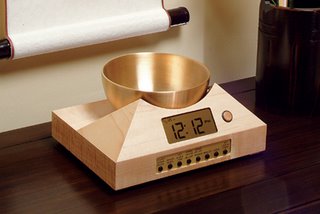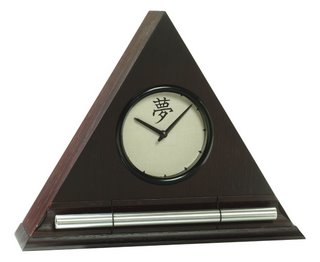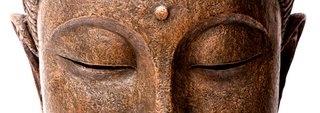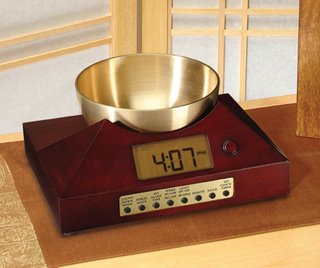|
 Secure Site
Secure Site
|
 |
 mindfulness tools & techniques Go Easy on Yourself
Let go of the idea that the goal of meditation is to stop thinking. “If you go in with that agenda, you’re in for a lot of frustration,” says Summers. The experience of meditation is different for everyone. The point isn’t not to think; it’s to be aware of your thoughts and learn to let them be.
adapted from Body + Soul
 Singing Bowl Mediation Timer and Clock Although meditation can be done in almost any context, practitioners usually employ a quiet, tranquil space, a meditation cushion or bench, and some kind of timing device to time the meditation session. Ideally, the more these accoutrements can be integrated the better. Thus, it is conducive to a satisfying meditation practice to have a timer or clock that is tranquil and beautiful. Using a kitchen timer or beeper watch is less than ideal. And it was with these considerations in mind that we designed our digital Zen Alarm Clock and practice timer. This unique “Zen Clock” features a long-resonating acoustic chime that brings the meditation session to a gradual close, preserving the environment of stillness while also acting as an effective time signal.
 Mindfullness tools: Meditation Timer with Chime Now & Zen – The Zen Timer and Clock’s
(800) 779-6383
Posted in Meditation Timers, Meditation Tools, mindfulness practice
 meditation increases compassion Maitryadisu balani
The cultivation of friendliness creates inner strength. (Yoga Sutra III.24)
We typically think of our emotional range as something that is fixed and unchanging—a reflection of the personality we’re born with. But research is revealing the possibility that we may be able to cultivate and increase our ability to feel the emotional state of compassion. Researchers have found that feeling connected to others is as learnable as any other skill. “We are trying to provide evidence that meditation can cultivate compassion, and that you can see the change in both the person’s behavior and the function of the brain,” Lutz says.
So what does compassion look like in the brain? To find out, Lutz and his colleagues compared two groups of -meditators—one group whose members were experienced in compassion meditation, and the other a group whose mambers were not—and gave them the same instructions: to generate a state of love and compassion by thinking about someone they care about, extend those feelings to others, and finally, to feel love and compassion without any specific object. As each of the participants meditated in-side the fMRI brain scanners, they were occasionally interrupted by spontaneous and unexpected human sounds—such as a baby cooing or a woman screaming—that might elicit feelings of care or concern.
All of the meditators showed emotional responses to the sounds. But the more experienced compassion meditators showed a larger brain response in areas important for processing physical sensations and for emotional responding, particularly to sounds of distress. The researchers also observed an increase in heart rate that corresponded to the brain changes. These findings suggest that the meditators were having a genuine empathic response and that the experienced meditators felt greater compassion. In other words, compassion meditation appears to make the brain more naturally open to a connection with others.
These meditation techniques may have benefits beyond the experience of spontaneous compassion. A study by psychology professor Barbara Fredrickson and her colleagues at the University of North Carolina, Chapel Hill, and the University of Michigan, found that a seven-week lovingkindness meditation course also increased the participants’ daily experience of joy, gratitude, and hope. The more participants meditated, the better they felt. Participants also reported a greater sense of self-acceptance, social support, purpose in life, and life satisfaction, while experiencing fewer symptoms of illness and depression. This study provides strong evidence that chipping away at the illusion of separation can open us up to a far more meaningful connection to life.
adapted from Yoga Journal by Kelly McGonigal
 Zen Timepiece, a brass singing bowl clock and timer for meditation Now & Zen
743 Pine St.
Boulder, CO 80302
(800) 779-6383
Posted in Bamboo Chime Clocks, intention, Meditation Timers, mindfulness practice, Now & Zen Alarm Clocks, Well-being, Zen Timepiece by Now & Zen, Zen Timers
 tranquillity In Buddhism, passaddhi refers to tranquility of the body, speech, thoughts and consciousness on the path to enlightenment. As part of cultivated mental factors, passaddhi is preceded by joy (pīti) and precedes concentration (samādhi).
adapted from wikipedia.org
 Digital Zen Timers, a mindfulness practice tool
Posted in Japanese Inspired Zen Clocks, Now & Zen Alarm Clocks, Progressive Awakening, Yoga Timer
 mindfulness meditation Put it into Practice.
Mindfulness requires concentration, but rather than concentrate on any one object, we concentrate on the moment and whatever is present in that moment.
To begin, take a comfortable seat. Set your Zen Timer for 20 minutes. Bring attention to your breath by placing your awareness at your belly and feeling it rise and fall. This will help you tune in to the sensorial presence of the body. Once you
feel settled, widen your awareness to include all the sensations in your body as well as any thoughts or feelings.
Imagine yourself as a mountain. Some thoughts and feelings will be stormy, with thunder, lightning, and strong winds. Some will be like fog or dark, ominous clouds. Inhaling, note “mountain.” Exhaling, note “stable.” Use the breath to focus on the present moment; cultivate the ability to weather the storm. If you find yourself swept up in
a thought or emotion, notice it and simply return to the breath. The key is to pay attention to the ever-changing process of thinking rather than to the contents of your thoughts. As you begin to see that they are indeed just thoughts, they will begin to lose their power. You will no longer believe everything you think! Continue to watch and become mindful of your thoughts, feelings, and sensations for 5 to 20 minutes. Remember to set your Zen Timepiece to signal the end to this meditation.
adapted from Yoga Journal, by Kelly McGonigal
 Zen Timepiece, a meditation timer with bowl/gong Now & Zen
1638 Pearl Street
Boulder, CO 80302
(800) 779-6383
Posted in Bamboo Chime Clocks, intention, Meditation Timers, Meditation Tools, mindfulness practice, Now & Zen Alarm Clocks, Well-being, Zen Timepiece by Now & Zen, Zen Timers
 mediation and prayer Praying has a healing power.
A study by the Californian cardiologist Randolf Byrd helped inspire Larry Dossey to get involved in the healing power of prayer. In 1988 Byrd studied 393 heart patients. They were randomly divided into two groups using a double-blind technique, which means that neither the patients, nor the doctors or nurses knew to which group the patients belonged. Catholic and protestant prayer groups were given the names and health conditions of patients from the first control group and every day they directed their prayer to someone from that group. No prayers were said for the patients from the second control group. The group for which prayers were said needed five times fewer antibiotics than the other group, had three times less lung oedema and no one needed intubation to help them breathe, as opposed to 12 people in the other control group.
Larry Dossey has since become an authority in the area of ‘medicine at a distance’. He is more than convinced that prayer works: ‘Studies have irrefutably proven that people on a spiritual path – whereby meditation or prayer play a role – live an average of 7-13 years longer than those who are not. Moreover, cancer and heart disease are significantly less prevalent among those who pray or meditate. Prayer has an effect on nearly every living organism it has been tried on: people, various cells and tissue, animals, plants and organisms such as bacteria, fungi and yeast. At least 130 controlled laboratory experiments have been done.’
‘Prayer is communicating with the creative powers of the universe, with the extrasensory. There are different types of prayer: the appeal for something for yourself, the meditation in which you ask something for someone else, veneration, plea… In every case we go beyond our mind, which tends to think that it can solve everything by itself.’
Prayer to Dossey is not something holy that is only reserved to pious churchgoers: ‘Everyone can pray, even if you don’t believe in God. A friend of mine prays to “To whom it may concern”. Research clearly indicates that the intention of the prayer is important to the result. When you pray, do so with your whole heart, like a child, from a place of wonder, innocence and sincerity.’ One more tip: ‘There is not just one good way to pray. You can pray for something specific, give thanks or simply ask for help. When facing something difficult, for instance: “Come on God, help me out here.” It works! Try to find your own way to pray. If your wording becomes too formal, it often loses its power.’ Dossey remembers once sitting in a room during a lecture by a theologian. Someone asked: ‘How exactly should you pray?’ Her answer: ‘It’s very simple, ask God.’
 Dark Oak Zen Alarm Clock with Chime, a Meditation Timer Now & Zen
1638 Pearl Street
Boulder, CO 80302
(800) 779-6383
Posted in Bamboo Chime Clocks, Meditation Timers, Meditation Tools, mindfulness practice, Well-being, Zen Timepiece by Now & Zen, Zen Timers
 watsu
Watsu, a portmanteau of water and shiatsu, is a form of body massage performed while lying in warm water (around 35 °C or 95 °F). The receiver of Watsu treatment is continuously supported by the therapist while he or she rocks and gently stretches the body. Because it is performed in the water, the body is free to be manipulated and stretched in ways impossible while on the land. A normal session would a professional hour of 50 minutes. Many Watsu practitioners us the Zen Timer to end their sessions.
 Bamboo Digital Chime Clock, a Watsu Timer and Clock Watsu was created by therapist Harold Dull in the early 1980s, then director of the Harbin School of Shiatsu and Massage in northern California. The technique slowly evolved as he began to incorporate aspects of Zen Shiatsu into his therapy. Watsu pools have now been introduced as a therapeutic passive massage tool as in the 2008 Turkish hamams Lake Conroe resort project.
adapted from wikipedia.org
 watsu Now & Zen
1638 Pearl Street
Boulder, CO 80302
(800) 779-6383
Posted in Bamboo Chime Clocks, Chime Alarm Clocks, Hot Springs, Japanese Inspired Zen Clocks, mindfulness practice, Well-being
 zen appreciation If you have been browsing on-line you may have seen a Google Ad-words for the search term “Buddhist alarm clock” that leads to our website www.Now-Zen.com.
“Buddhist Alarm Clock” is not a product name or search term we created, but instead one that people have been using on their own. We are the makers of the world famous “Zen Alarm Clock” and although we are using the word “Zen” as part of our trademark, we are not trying to associate directly with Buddhism or any other organized religion. We have no control over “Buddhist Alarm Clock” being used by Google.
The founders of our company have great respect for the spiritual teachings and the aesthetic achievements of Buddhism, but we also respect and appreciate a wide variety of other spiritual paths as well. Zen is the name of an ancient form of Japanese Buddhism, but ever since Robert Pirsig’s famous book, Zen And The Art of Motorcycle Maintenance, was published in 1974, the word “Zen” has come to have a larger meaning within American popular culture. Zen also connotes a sort of nondenominational metaphysical quality that transcends any particular spiritual forms or teachings. The word evokes the image of a beautiful rock garden or a weather beaten pine tree on a windswept mountainside.
The timeless aesthetics of Zen Buddhism did provide inspiration for our Zen Alarm Clock, but the design also arose from other influences, such as the sublime patterns of sacred geometry. We thus use the word “Zen” in the name of our product as a kind of lighthearted tribute to progressive spiritual culture. But, as we have been careful to explain over the 15 years we have been in business, we make products for both spiritual and non-spiritual people and we are not directly associated with Buddhism or any other specific form of spirituality.
Our motto is “quality of thought, stillness of being” and we hope that this is the kind of spiritual message that everyone can appreciate.
We apologize any confusion that the Ad-words search term “Buddhist Alarm Clock” may have caused. If you continue to have any questions at all, please contact us or visit www.now-zen.com for more information.
Posted in Chime Alarm Clocks, Japanese Inspired Zen Clocks, Natural Awakening, Now & Zen Alarm Clocks, Progressive Awakening, zen
 - Well-being
Exhaustion Cause: Shallow Breathing
Breathing is our most elemental and immediate need. But there’s a big difference between breathing to survive and breathing to thrive. “Most people I meet take shallow, rapid breaths, using only about a third of their lung capacity,” says Weil. You need oxygen to metabolize your food so your body can produce energy. “Not breathing fully and efficiently has a huge effect on your vitality.”
Most of us don’t often stop to consider the way we breathe. “We don’t pay attention to it because we’re never taught to,” explains Weil.
Exhaustion Cure: Extend Your Exhalations
If you make a conscious effort to deepen your breathing, says Weil, “you’ll sleep better, gain more control over your moods, experience less fatigue, and have better energy overall.” Rather than start by taking a big, deep inhalation, increase your breathing efficiency with a focus on breathing out. “We have more voluntary control over the exhalation,” he explains. By learning to use the intercostal muscles (between the ribs) to expel more air from the lungs, “inhalation will automatically increase.”
For best results, Weil recommends spending a little time every day on breathwork. “Keep it very simple. For several minutes, simply squeeze at the end of every exhalation. You don’t have to sit in any special posture. You can do this anywhere, but lying in bed is a good place to start. Over time, your breath will become more regular, quieter, and deeper.” And your energy level will grow stronger. Remember to set your Zen Timer for a several minutes to remind yourself when to end your practice with a sweet chime sound.
adapted from Body + Soul, September 2009
 Dream Kanji Zen Alarm Clock with chime in Dark Oak Finish, a wellness tool for remembering dreams Now & Zen
1638 Pearl Street
Boulder, CO 80302
(800) 779-6383
Posted in Bamboo Chime Clocks
 mindful walking When you apply a few simple techniques, you can turn your daily walk into a rewarding practice.
What is mindful walking? It’s a technique that uses awareness of the mind/body connection to improve the quality of your walking experience on all levels. By approaching a walk in a mindful way, you make it a practice like yoga, meditation, or tai chi; every session brings new insights and challenges. As in yoga, you think about your body position, breathing, movements, and awareness, turning inward and outward at the same time. You’re working to get fit, and to improve your life as a whole. Treat walking as a practice, and it will become not only something you do with your legs but also a way to bring your mind, body, and spirit into balance.
Five Steps to Make Walking a Mindful Practice
Identify your intention. The key to any mindful activity, intention provides focus and motivation, elevating your practice from routine to ritual. What is your intention? To walk for an hour every day? To develop a sense of centeredness and calm? To reduce stress? Your goals and intentions will evolve as you evolve. Let them, as long as they keep you in line with your higher sense of purpose — and keep you moving forward.
Be consistent. A true practice requires ongoing attention. Of course, it’s natural to feel resistant at times, no matter what kind of activity you do. Your mind will create a thousand excuses not to walk today. Don’t let these passing thoughts distract you from your deeper intention. Get moving; start walking around your office or home, or wherever you are. You can quiet the mind by moving your body and get yourself back on track.
 train your mind to focus Train your mind to focus. The mind loves — and craves — engagement. Without something to focus on, it will tend to wander, taking your practice with it. By learning to focus, you will be able to walk more efficiently.
Listen to your body. As with any relationship, the connection between mind and body depends on how well one listens to the other. Our tendency is to try to rule the body with the brain; however, they are more like equal partners, offering feedback and direction as you go. Listen to what your body is trying to tell you by noticing any sensations that come up while you’re walking. You may feel energized as your leg muscles engage or relaxed as your breathing deepens. If you detect any complaint from your body, such as pain or discomfort, identify the source. Then make small adjustments in your technique and see whether the sensation lessens.
Embrace the process. Goals provide a greater context for your practice. But building patient awareness of the process is even more important. Sometimes walking will feel easy and rewarding; other times, more like a chore. As part of a mindful practice, you accept the challenge as part of the process and continue to stick with it. My tai chi master sees difficulty as an opportunity — a lesson to be learned. Accepting all of these parts of the process lies at the heart of making walking a mindful exercise.
adapted from Body + Soul Magazine, April/May 2006
 Meditation Timer, The Digital Zen Alarm Clock in Solid Walnut Now & Zen
1638 Pearl Street
Boulder, CO 80302
(800) 779-6383
Posted in Japanese Inspired Zen Clocks, mindfulness practice, Now & Zen Alarm Clocks, Uncategorized, Well-being, Zen Timers
 zen-like garden, a perfect meditation space to use your Zen Meditation Timer A couple of years ago, I heard Diane Ackerman, who writes beautifully about gardens and gardening, discussing her passion on National Public Radio. She and the host agreed that our gardens reflect ourselves, our way of looking at life. I thought about my own garden, and I liked the idea. My lavender was just plumping with sweet-smelling buds, the vinca was fresh and green with perky purple flowers, and the peonies held promise in their tight little fists.
That was in June. By August, the thought of my wild, out-of-control garden reflecting anything about me was slightly horrifying. The lemon balm had run amok; the peony bush—never caged—was limp and trampled. In my backyard, a virulent type of Japanese knotweed had grown into a jungle. As it does every year, nature had taken its course in my yard, and I hadn’t managed to keep it in check. Oh, the temptation to just call it wabi-sabi and leave it at that. It was, after all, very natural in its untidy way.
But I know better. Wabi-sabi is tamed, subdued, and serene. I know that the natural gardens I inevitably fall for—which feel almost untouched by human hands—actually owe their serenity and peace to hours of hard labor. There’s a fine art to creating a garden that feels close to nature but also offers carefully thought-out spots for meditation and reflection, just the right combination of color and blooms throughout the season, and enough structure and muscle to provide interest even in December. One where I can use my Zen Timepiece to each day to do my mindfulness practice. A truly wabi-sabi garden is a creative endeavor of the highest sort. (And some day—when my kids are older and my work life slows down—I vow I’ll accomplish that.)
 Zen Timepiece with brass singing bowl, a meditation timer I’m slowly working toward my wabi-sabi paradise by putting in plants that are native to my place: slightly weedy black-eyed Susans and columbine, wild rosebushes dug up from my neighbor’s yard, heat-loving yarrow. I’ve welcomed intruders, if they have something to offer and don’t get too pushy. The chokecherry that made its way down from the foothills near my house provides long, delicate white blossoms in springtime and brilliant red-orange leaves in the fall (great branches to bring inside). The mullein that planted itself in my flower garden is tough and phallic, but the bloom of tiny yellow flowers around its stalk in late summer expresses its feminine side.
These indigenous species, adapted to my brutal high-desert climate, can take care of themselves and manage to look good—even in August—without a lot of care and attention. The creative part, for me, is mapping out where they’ll thrive and how they’ll interact with each other and with the humans who visit. And this is where the wabi-sabi spirit really comes in. The wabi-sabi garden embraces and enhances the delicate balance between nature and nurture. It’s not formal and prissy like an English garden—but it’s not overrun with lemon balm and knotweed. Plants are chosen because they belong in that garden, in that climate. They’re allowed to strut their stuff, but they’re expected to be considerate of the plants around them—or be tamed. Brash, blowsy blooms, which generally require a high degree of maintenance, are used sparingly, if at all.
Just as important as what plants are chosen and where they’re placed are the garden’s bones: the stones and pebbles used to create winding paths and delineations, the rusty iron gate beckoning entrance, the trellis teasing vines up its length. In this aspect, gardens offer all sorts of wabi-sabi opportunity. Place an old, broken-down chair in the flowerbeds; let the weather work its magic and the plants grow up around it until it seems rooted and organic to that place. Plant gourds in an old wheelbarrow and let them spill languidly over the sides. Build a stone wall; the very act of placing stone upon stone is a satisfying meditation. Create paths that encourage guests to meander, with stopping points where the vista is ideal.
With the right structure in place, the wabi-sabi garden is as beautiful—if not more so—in December as it is in June. The sculptural bare branches, brittle seedpods, and somber palette of the winter garden are as wabi-sabi as it gets. Stark and naked, the plants stand as vivid symbols of nature’s way: birth, death, rebirth. The blossoms of life are easy to admire; the quiet integrity of plants gathering energy for rebirth takes a deeper appreciation. A stroll through the garden in the dead of winter is a fine place to cultivate that depth.
Adapted from Natural Home Magazine, March/April 2005 Reprinted with permission from The Wabi-Sabi House: The Japanese Art of Imperfect Beauty by Robyn Griggs Lawrence (Clarkson Potter, 2004).
Posted in Bamboo Chime Clocks, Chime Alarm Clocks, Japanese Inspired Zen Clocks, Now & Zen Alarm Clocks, wabi-sabi
|
|
|
|